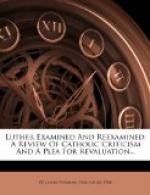Out of such conditions grew Luther’s work. But on these conditions Catholic critics of Luther maintain a discreet—shall we not say, a guilty?—silence. Few Catholic laymen to whom the horrors of Luther’s life are painted with repulsive effect know the horrors which Luther faced. They are only told that Luther attacked “Holy Mother.” They are not told that “Holy Mother” had become the harlot of the ages.
6. Luther’s Birth and Parentage.
Catholic writers make thorough work in explaining the reasons for Luther’s “defection” from Rome. They apply to Luther’s stubborn resistance the law of heredity: Luther’s wildness was congenital. Some have declared him the illegitimate child of a Bohemian heretic, others, the oaf of a witch, still others, a changeling of Beelzebub, etc.
Many of these writers, giving themselves the airs of painstaking investigators who have made careful research, repeat the tale of Barbour, viz., that Luther was born in the day-and-night room of an inn at Eisleben. If this is so, Luther’s mother must have been a traveler on the day of her first confinement. If this were so, the fact could, of course, be easily explained without dishonor to Luther’s mother: she merely miscalculated the date of the birth of her first-born,—not an unusual occurrence. Carlyle believed this story, but gave it an almost too honorable turn, by likening the inn at Eisenach to the inn at Bethlehem.
But this story of Luther’s birth in a bar-room is not history; it belongs in the realm of mythology. Nobody knows to-day the house where Luther was born. Preserved Smith, his latest American biographer, says there is a house shown at Eisleben as Luther’s birthplace, but it is “not well authenticated.” (p. 2.) There is a bar and a restaurant in this particular building now, for the accommodation of foreign visitors. It is possible that in this mythical birthplace of Luther you can get a stein of foaming “monk’s brew” or a “benedictine” from the monastery at Fecamp, or a “chartreuse” from Tarragona, distilled according to the secret formula of the holy fathers of La Grande Chartreuse. If you sip a sufficient quantity of these persuasive liquors, you will find it possible to believe most anything. And the blessing of the holy fathers who have prepared the beverages for your repast will be given you gratis in addition to their liquors.




